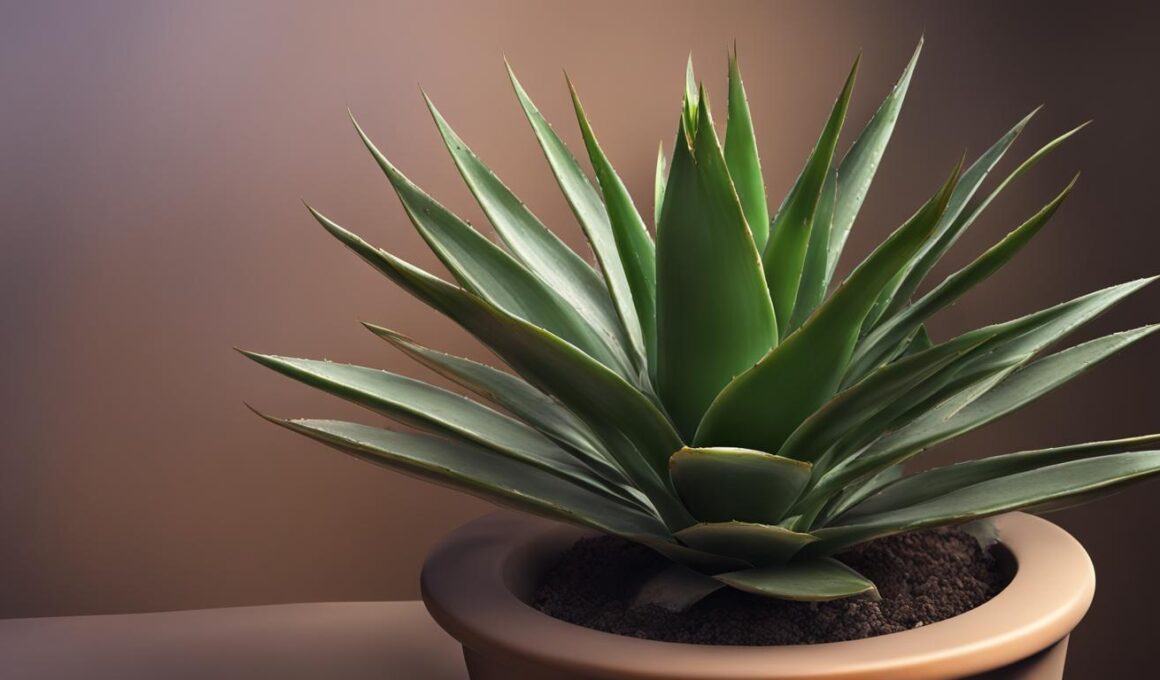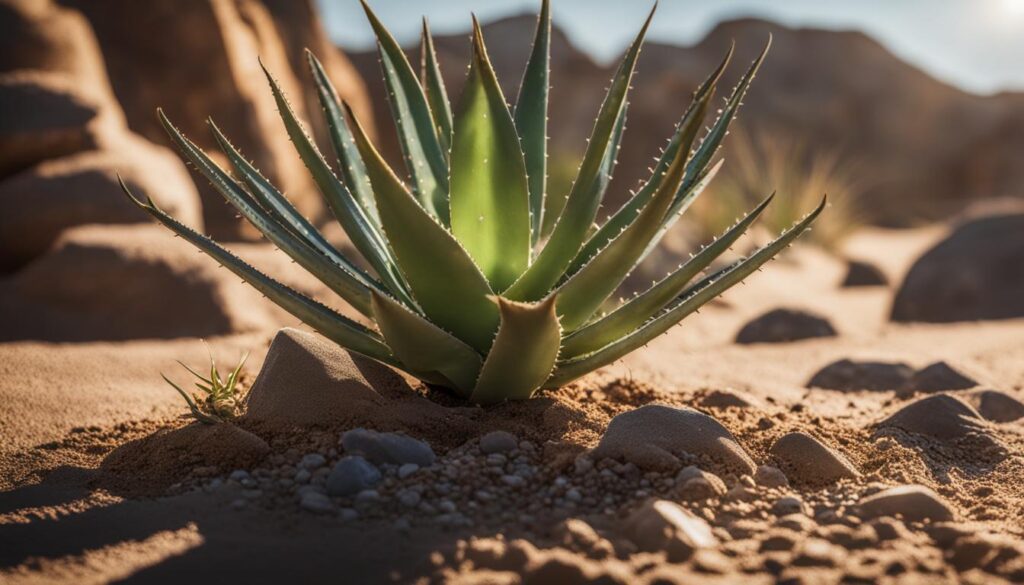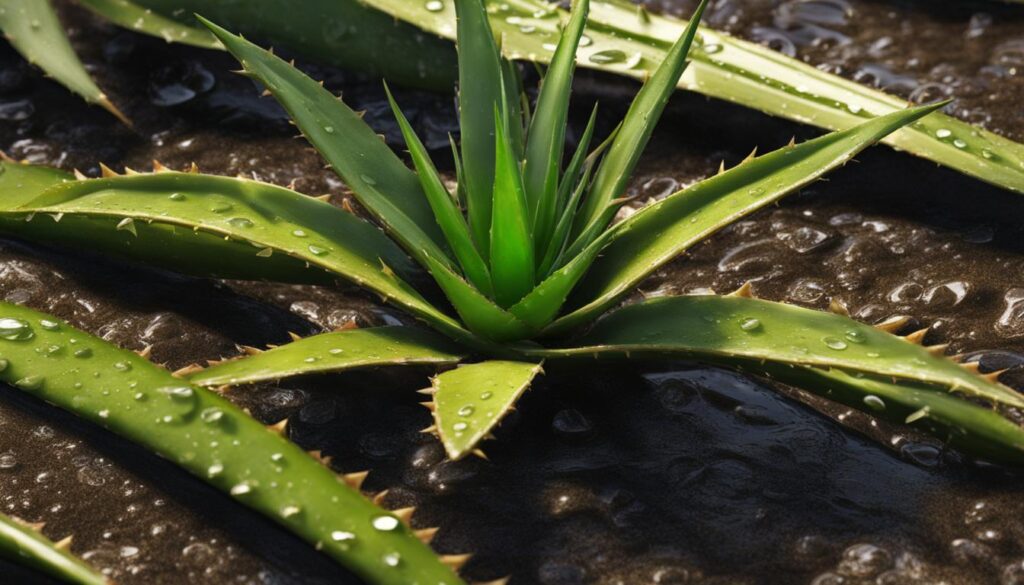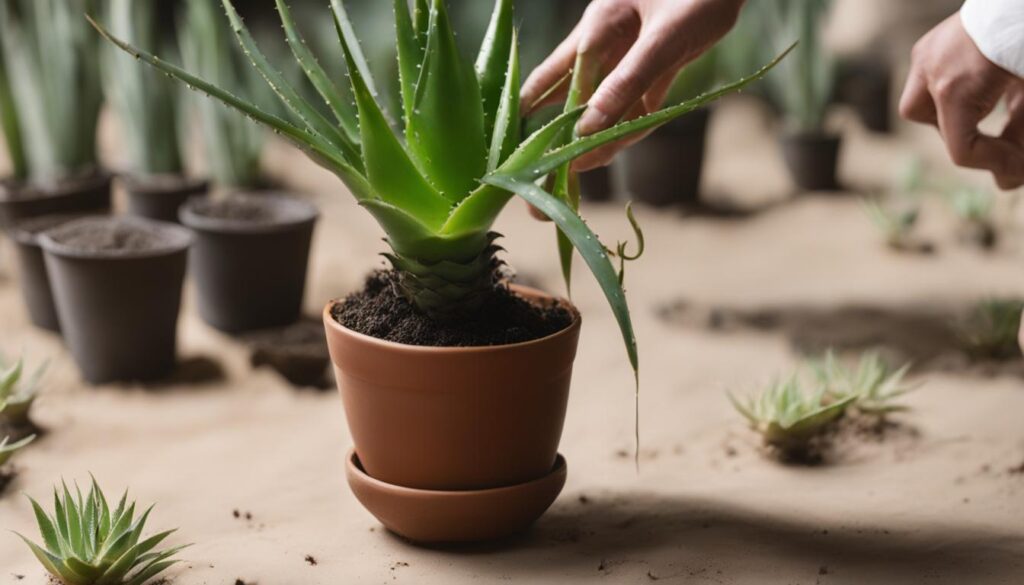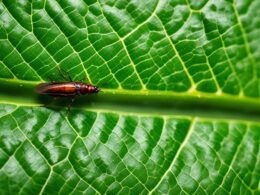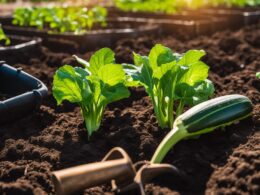Aloe vera plants provide both beauty and functionality, serving as great additions to any home. However, these succulents can sometimes exhibit drooping leaves, signaling stress often due to changes in their environment. To maintain your aloe vera plant’s health and prevent drooping, it’s crucial to understand the reasons behind it and provide proper care tailored specifically to its preferences. In this article, we’ll explore the possible factors contributing to a drooping aloe vera plant and offer solutions to help revive it.
Key Takeaways
- Aloe vera plants may droop as a result of stress factors like temperature shock, improper lighting, poor drainage, and pot-bound roots.
- Understanding an aloe vera’s natural habitat and environmental preferences can help you provide optimal care and avoid drooping.
- Overwatering and under-watering can both lead to drooping in aloe vera plants, so it’s important to create a unique watering routine based on the plant’s specific needs.
- Pot and soil choices play crucial roles in aloe vera plant care: proper drainage and a well-draining soil mix contribute to healthy plant growth and prevent drooping.
- Treating root-bound aloe vera plants by repotting them in a larger pot with fresh succulent soil and proper drainage can alleviate stress and prompt revitalized growth.
- Pest infestations and fungal diseases, often caused by overwatering, can result in drooping leaves; identifying and treating these issues can help promote recovery.
- Regularly monitoring and adjusting care practices as needed can ensure a thriving, resilient aloe vera plant in your home.
Understanding Aloe Vera’s Natural Habitat and Environmental Preferences
Aloe vera plants are native to the hot and arid regions of Africa, Madagascar, and the Arabian Peninsula. These environments offer consistently warm temperatures and ample sunlight, which are crucial for the plants’ growth and health. By understanding and emulating these conditions in your home, you can create the ideal environment for your aloe vera plant and prevent drooping leaves. This section will discuss the importance of temperature and lighting conditions in promoting healthy aloe vera plants.
Temperature Shock: The Effect of Sudden Climate Changes on Aloe Vera
Aloe vera plants thrive in temperatures ranging from 60°F to 80°F and can be sensitive to temperature shock when exposed to sudden changes or drafts. Rapid fluctuations in temperature can cause the leaves to wilt or droop as the plant struggles to adapt. To create optimal conditions for your aloe vera plant, consider the following:
- Avoid Placement Near Drafts: Keep aloe plants away from open windows, air conditioning units, or heating vents that could produce sudden changes in temperature.
- Acclimate Gradually: If you need to change the plant’s location, allow it time to adjust by gradually moving it to its new environment over a few days.
- Monitor Temperature: Maintain an ambient temperature within the ideal 60°F-80°F range by regularly checking conditions in the room where your aloe is situated.
Optimal Lighting Conditions for Aloe Vera Health
Aloe Vera Sunlight Requirements dictate that these plants need at least six hours of light daily to maintain optimal health. Insufficient or excessive light exposure can lead to elongated and thin leaves, ultimately causing the plant to droop. Here are some tips for ensuring proper Aloe Plant Lighting:
- Position your aloe on a bright windowsill, shelf, or another area free of drafts and not exposed to direct, harsh sunlight for the entire day.
- Rotate the plant occasionally to ensure even light distribution and avoid overexposure on one side.
- Monitor your aloe throughout the day to ensure it receives sufficient natural light. If necessary, consider using artificial light sources, like grow lights, to supplement daylight exposure.
By familiarizing yourself with the Aloe Vera Temperature Tolerance and Optimal Lighting for Aloes, you can better care for your aloe vera plant and prevent drooping leaves. Paying close attention to these critical environmental factors will promote healthy, resilient plants and enhance your indoor gardening experience.
Signs and Solutions for Improper Watering Practices
Both overwatering and underwatering can cause aloe vera plants to droop. To maintain a healthy aloe vera, it’s essential to evaluate your plant’s watering schedule and make adjustments if necessary. Factors to consider include temperature, humidity, light, soil type, and pot size. Overwatered aloes may have soft, mushy, discolored leaves, while underwatered plants can appear dull and deflated. To prevent these issues, create a unique watering routine based on your plant’s needs and allow the soil to dry out between watering sessions. This prevents over-moisturized soil and root rot.
- Waterlogged soil
- Mushy, discolored leaves
- Dull, deflated appearance
- Root rot
Aloe Vera Watering Guide
Developing a consistent watering schedule is crucial to properly caring for your aloe plants. To create an effective aloe vera watering guide, follow these steps:
- Monitor the top inch of soil for dryness; water your plant only when this layer is completely dry.
- Keep room temperature and humidity levels stable, avoiding fluctuations that can stress your plant.
- Ensure your aloe receives adequate light to accommodate its watering needs.
- Choose a pot with drainage holes and proper succulent soil to prevent overwatering.
- Adjust your watering schedule to accommodate your plant’s individual needs and environmental conditions.
By following these steps, you can create a customized watering routine that supports your aloe vera’s overall health and well-being.
Preventing Overwatering Aloe Vera
Overwatering aloe plants can lead to a host of complications, including drooping leaves and root rot. To prevent overwatering, consider implementing the following preventative measures:
- Ensure your pot has drainage holes to release excess water.
- Use a well-draining soil mix specially formulated for succulents and cacti.
- Adjust your watering schedule based on your plant’s individual needs and environmental conditions.
- Monitor soil moisture levels before watering to avoid oversaturating the soil.
Taking these steps can help you avoid overwatering your aloe vera and maintain a healthy, vibrant plant.
Addressing Underwatering in Aloe Plants
While aloe vera plants can tolerate some degree of drought, underwatering can still cause leaves to droop and appear dull. To prevent underwatering and ensure proper plant health, consider the following strategies:
- Monitor soil moisture levels and water your plant when the top inch of soil is dry.
- Be mindful of your plant’s specific watering needs based on its size, location, and environmental conditions.
- Adjust your watering schedule during periods of high heat or low humidity to accommodate your plant’s increased water needs.
- Consult aloe vera watering guides and experienced caretakers to perfect your watering methods.
By addressing the root cause of your aloe vera’s drooping leaves, you can adjust your watering practices accordingly to promote healthy, vibrant growth.
Drainage Dilemmas: How Your Pot and Soil Affect Aloe Vera’s Growth
Proper drainage is essential to maintain the health of your aloe vera plant. Both pot and soil choice play crucial roles in effective water management and ensuring your aloe remains healthy and vibrant. In this section, we’ll explore the essential elements of a well-designed potting environment that supports a thriving aloe vera plant, and signs to look out for when overwatering occurs.
Choosing the Right Soil and Pot for Effective Water Management
When it comes to Aloe Vera Potting Tips, one of the most critical factors in supporting optimal Aloe Vera Plant Health is proper drainage. Your choice of pot and soil should facilitate effective water management, ensuring your aloe thrives. Non-draining pots can create pockets of water that harbor bacteria, leading to root rot, which can cause drooping leaves.
- Opt for a container with ample drainage holes to prevent standing water.
- Choose a specialized Succulent Soil Mix to provide the right balance of nutrients without retaining excess water.
- Consider using a porous material, such as terracotta, that allows for better Aloe Plant Drainage.
Recognizing Overwatering Symptoms and Corrective Steps
Signs of Overwatering in aloe vera plants can lead to drooping and other complications. Overwatered aloes may display numerous symptoms, such as:
- Wilted or distorted leaves
- Leaves that become soft or change to a yellow or brown color
- Mushy and deteriorating roots
If overwatering is suspected, the following corrective steps may help revive your plant:
- Allow the soil to dry out completely before the next watering session.
- Repot the plant in fresh soil with proper drainage to ensure a healthier environment.
- Avoid creating a habitual watering schedule and instead water based on the plant’s current needs, checking soil moisture regularly.
By focusing on the essential elements of Aloe Vera Potting Tips and paying attention to the Signs of Overwatering, you can ensure Aloe Vera Plant Health and confidently address drainage dilemmas in your aloe vera plant’s environment.
Resolving Root Bound Issues in Aloe Vera Plants
Aloe vera plants that become root-bound may exhibit droopy leaves as a sign of being pot-bound. This can occur when a plant outgrows its container, leading to tightly curled roots that can no longer properly expand. Inspecting the root system of your aloe plant is a crucial step in resolving root-bound issues and revitalizing its growth.
How do you identify a root bound aloe plant? Gently remove the plant from its pot and examine the roots. If roots are constricted or spiraling, it is a clear indication that your aloe vera plant is root bound.
- Choose a slightly larger pot: Repotting the aloe vera into a slightly larger pot will provide more room for the roots to grow and prevent constriction. The new pot should have proper drainage holes to accommodate the aloe’s root system and maintain healthy growth.
- Use a suitable soil mix: Fresh succulent soil is necessary for repotting aloe vera plants. A well-draining soil mix, specially formulated for succulents and cacti, will help prevent soil compaction and excess water retention that can further lead to root-bound issues.
- Trim damaged roots: Before repotting, carefully trim away any damaged or rotting roots to promote healthy growth and reduce the risk of root rot.
- Monitor your plant: After repotting, keep a close eye on your aloe vera plant’s progress. It may take some time for the plant to adjust to its new environment, but with proper care and attention, it should start to show signs of revitalization and growth.
By following these simple steps, you can repot your root bound aloe plant and help it overcome the stress of being pot-bound. A revitalized aloe vera plant will grow more robust and vibrant, enhancing the beauty and wellbeing of your indoor garden.
Pest Infestations and Diseases: Identifying and Treating the Intruders
Aloe vera plants can fall victim to various pests and diseases that cause them to droop. To maintain a healthy plant, understand how to identify and treat these intruders. In this section, we will discuss the common pests known to cause aloe vera to droop and fungal diseases that can lead to root rot.
Common Pests That Cause Aloe Vera to Droop
Aloe Vera Pests such as gall mites, spider mites, and fungus gnats can damage the plant’s tissue and impair its ability to absorb nutrients, leading to drooping leaves. It’s important to identify and treat these Plant Pest Infestations for the health of your aloe plant. Here’s a list of common pests and their symptoms:
- Gall mites: Small, pin-prick holes on aloe leaves and distortion.
- Spider mites: Fine webs near the base of the leaves or along the stems.
- Fungus gnats: Tiny, black insects near the soil surface, visible to the naked eye.
Upon identifying such symptoms, remove affected soil and treat the plant with a neem oil-based insecticide. Neem oil is a safe and effective solution for Treating Aloe Bugs, helping to eliminate these common pests.
Fungal Diseases and How to Prevent Them
Fungal diseases, often caused by overwatering, can lead to drooping aloe vera leaves. The most common fungal diseases that can affect aloe vera plants are rust and basal stem rot. To prevent such Aloe Vera Fungal Diseases, ensure proper watering habits (allowing the soil to dry completely between watering sessions) and provide good air circulation within and around the plant.
When a fungal disease is already present, follow these steps:
- Remove infected parts of the plant.
- Treat the aloe with a Plant Fungicide to eliminate remaining spores and promote recovery.
- Monitor the plant closely for any signs of recurrence and treat as needed.
Preventing Root Rot is crucial for maintaining healthy aloe vera plants. Following proper watering habits and keeping pests and diseases at bay are key steps to ensure the well-being of your aloe vera plant.
Repotting Your Aloe: When and How to Give Your Plant More Space
When an aloe vera plant shows signs of drooping due to being root-bound or having outgrown its current pot, it’s time to consider Aloe Vera Repotting. Repotting Succulents like aloe vera can be a simple process if you know when and how to do it. In this section, we’ll discuss when to repot aloe and the steps to give your plant the space it needs for healthy growth.
- Inspect your aloe vera plant for signs of being root-bound or having outgrown its current pot. If the plant appears to be struggling within its space, or if the roots are visible at the soil surface, it’s time for repotting.
- Choose to repot during the growing season, which is typically from spring to fall. This will allow the plant enough time to regrow and acclimate to its new pot before the dormant season begins.
- If the aloe plant has recently been exposed to stressors such as temperature changes, pests, or disease, give it time to recover before repotting.
Steps for Aloe Vera Repotting
- Carefully remove the aloe plant from its current pot, trying not to damage its roots.
- Inspect the roots for any signs of rot, disease, or pests. Remove any affected areas with clean, sterilized scissors or shears.
- Select a new pot one or two sizes larger than the current one, ensuring it has adequate drainage holes.
- Prepare a well-draining soil mix appropriate for succulents. You can purchase a premixed succulent potting soil or create your own mixture by combining equal parts of potting soil, perlite, and coarse sand.
- Fill the new pot with a layer of soil mix and gently place the aloe plant in the center.
- Add more soil mix around the aloe, ensuring it covers the root system and supports the plant’s base. Tamp down the soil gently to eliminate air pockets.
- Water your newly-repotted aloe sparingly, just enough to moisten the soil. Wait at least a week before resuming regular watering to allow the plant to adjust to its new pot.
By following these guidelines, you can successfully repot your aloe vera plant and give it the space it needs to thrive. A properly repotted plant will not only grow more vigorously, but will also be more resistant to stressors that can lead to drooping leaves and other health issues.
Can Lack of Blooming in Hydrangeas Cause Aloe Vera Plants to Droop?
The lack of blooming in hydrangeas should not directly cause aloe vera plants to droop. Aloe vera plants typically droop due to overwatering, underwatering, or lack of sunlight. Troubleshooting hydrangea blooming issues is important for maintaining their health, but it is unlikely to affect unrelated plants like aloe vera.
Conclusion
Reviving a drooping aloe vera plant requires careful evaluation and diagnosis of the underlying issues, such as incorrect watering, inadequate lighting, or temperature extremes. Aloe vera plants thrive in specific conditions that resemble their natural habitat, so it’s essential to provide them with the right environment to ensure optimal health. By following proper aloe vera plant care tips, you can revive your droopy aloe and maintain a healthy, resilient plant in your home.
Regular monitoring of your aloe vera plant’s health is crucial to preventing droopiness and other stress symptoms. Pay attention to changes in your plant’s appearance, and address any concerns promptly to avoid long-term damage. Ensure that you are watering your plant appropriately and providing adequate light, adjusting care practices as needed to best support your aloe vera’s growth and well-being.
Lastly, don’t forget to address root-bound issues, pest infestations, and diseases promptly to prevent further complications. Regular maintenance and proper care can go a long way in preserving the health and beauty of your aloe vera plant, providing you with a thriving, flourishing succulent for years to come.





